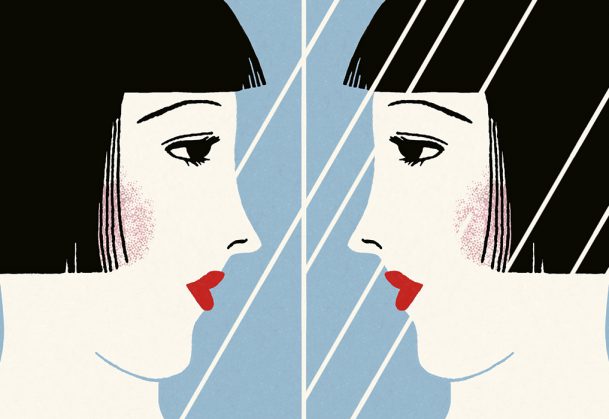
Martin Goodson
The Story of Eno Daikan 3: The True Face of Elder Myo
In this final part of Eno Daikan's story, having received the Buddha's robe and bowl, he flees the monastery only to be pursued and caught by the Elder Myo. It is at this point Eno delivers his famous Koan.

Face in mirror
When Master Gunin (the Fifth Patriarch) saw the verse he know too that the one who composed it had clearly seen and also knew who that this was by Eno (Huineng).
Later on he went to the rice hulling shed and rapped three times on the door jamb then walked away.
Eno knew that was a message to go to the Patriarch’s quarters at the third watch of the night.
This he did and the Patriarch questioned him further to test and deepen Eno’s insight before transmitting the Buddha’s robe and bowl and conferring upon him the status of Sixth Patriarch.
The Buddha’s robe and begging bowl were the outward signs of the transmission of True Dharma from heir to heir going back to Mahakasyapa who was given it by Buddha Shakyamuni himself.
In Buddhism there is no organised ‘church’ or supreme hierophant who decides what is true and what is not. When we come to a teacher we find out what is her or his lineage.
So, lineage is used as a sign of authenticity; because it is possible to trace a teaching back to its roots we can check whether or not this is really a teaching of Buddha.
Gunin then instructed Eno to go south immediately as he feared for his safety if Eno stayed.
We may wonder about this instruction? Surely in a Buddhist monastery no one would dare raise a hand to him?
But jealousy runs deep and just because a man wear monks robes does not mean his heart is not that of a sneaky fox or an irritated bear!
The following day when Gunin failed to give the usual mid-day sermon the monks realised that something had happened. Finally, Gunin told them the ‘canon of teaching’ had gone. The monks thought it meant that something material (robe and bowl), had been stolen and set out to pursue the one person who was missing.
The story goes that after a long search one monk called Myo, who was an old soldier, finally caught up with Eno in the mountains.
As Eno head someone coming he laid down the Buddha’s robe and bowl on a rock and hid himself. When Myo approached Eno called out to him saying:
“If you have come for the robe and bowl, here it is. Lift it up for yourself.”
Myo seized hold of them but could not lift it.
Why could he not lift it?, They are just a robe and old bowl after all?
This forms the basis for a koan which is sometimes used in the interview room (sanzen).
Then Myo had a change of heart and called out to Eno, realising that if he could lift them he indeed must be truly the Sixth Patriarch.
“No, I have come for the Dharma, please say a turning phrase.”
This ‘turning phrase’ is one that often appears in the Zen stories when a student faces the master and is ripe for opening up. It is likened to the chick that is fully-formed but inside the egg. The inner surface is too smooth for the egg tooth and it cannot get out. So the mother hen pecks once to create an edge for the egg tooth to work on.
This peck is like the ‘turning phrase’.
The Sixth Patriach faced Myo and said:“Before thinking of good and bad, what is the True Face of the Elder Myo, before father and mother were born?”
This is the famous koan of ‘The True Face’ of the Sixth Patriarch.
It appears as number 23 in the collection known as the Mumonkan or the Gateless Gate of Master Mumon.
Mumon comments upon this koan saying that we should remember that Eno was in a tough spot and that he behaved with grandmotherly kindness. It is as if he peeled a lychee removed the stone and popped it into the mouth of Elder Myo; all he has to do is swallow!
‘Grandmotherly kindness’ is used as a form of rebuke in Zen but as usual we must never take anything at face value without looking carefully into it.
Suffice to say that Eno Daikan, the Sixth Patriarch spent 15 years maturing before teaching.
He became head of what is known as the Southern school of Zen Buddhism often referred to as the ‘Sudden School’. Jinshu, the Head Monk, went on to head up the Northern School known as the ‘Gradual School’. In time the latter school died out.
Even today, Eno’s sermons in the Platform Sutra are carefully studied by Zen students.







